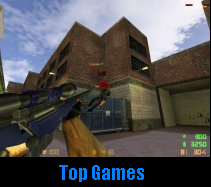
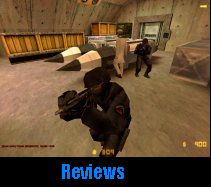
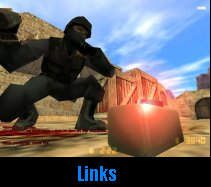

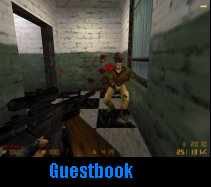
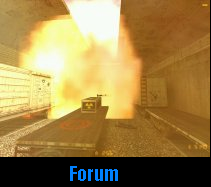
Home
Here are some first person shooting game reviews I've got from some sites. I think you will learn more background about the game if you read these reviews. Maybe the reviews can even make you interested in the game. Anyway, just read the long articles and enjoy. (I've noticed that it's not that boring!)
Quake 3
About The Game
Quake III is the third and final installment of the immensely popular Quake series from the originators of the First Person Shooter genre id Software. Quake III: Arena focuses on deathmatching, fast simple and arcade-like. It also features other gametypes such as CTF and includes complex bots for you to frag offline with.
Quake III was released in December of 1999 to good to lukewarm reviews. What stole the crown from Quake3 as the king of FPS's for the year 1999 was Epic's Unreal Tournament. However, this did not stop the Quake series' popularity altogether.
From The Manual
"Untold centuries ago the Vadrigar, the mysterious Arena Masters, constructed the Arena Eternal for their own infernal amusement. Virtually nothing is known of these beings except that they savor the carnage and clamor of battle. As such, they have stocked the arena with the greatest warriors of all time. And you have just joined their ranks."
"As a gladiator in the Arena Eternal, you must not only survive, but also win each and every battle against ever more powerful opponents. Don't worry overly much about getting "fragged." The Vadrigar won't be cheated of their favorite sport by a little thing like death. Those who fall are instantly restored to life and immediately thrust back into the battle, perhaps a little wiser for their misfortunes."
"When the dust, blood, and gibs settle, all warriors will have earned the right to battle again, providing further entertainment for the Vadrigar. But only the warrior who has fragged the most foes will be lauded as the winner. The victorious gladiator advances to a more challenging array of arenas, until, at last, he or she faces Xaero, Lord of the Final Arena."
In single-player mode, Quake III Arena is split into six tiers of four arenas each. In order to progress to the next tier, a gladiator has to beat all four arenas. Finishing second or third won't do-you must emerge as the clear winner.
While the rules are a little different in multiplayer (network or online) games, there is one important rule that sums up your life as a gladiator in the Arena Eternal:
FRAG EVERYTHING THAT ISN'T YOU.
Who Made Quake3: Arena?
id Software:
Christian Antkow - Level Designer
Adrian Carmack - Artist
John Carmack - Lead Programmer
John Cash - Programmer
Kevin Cloud - Artist
Graeme Devine - Design
Todd Hollenshead - CEO
Brian Hook - Programmer
Brandon James - Level Designer
Paul Jaquays - Level Designer
Katherine Anna Kang - Director Of Business
Kenneth Scott - Artist
Paul Steed - Modeler
Tim Willits - Lead Level Designer
What else did they make?
Wolfenstein 3D (May 5, 1992)
Doom (December 10, 1993)
Doom II (October 10, 1994)
Quake (1996)
Quake II (December 9, 1997)
Half-Life
The Story
Deep in the bowels of the Black Mesa Federal Research Facility, a decommissioned missile base, a top secret project is underway. A portal has been opened to another dimension, and human science has never seen anything like the world on the other side. You are Gordon Freeman, a young research associate in the Anomalous Materials Laboratory. You have limited security clearance and no real idea of just how dangerous your job has become, until the morning you are sent alone into the Test Chamber to analyze of a strange crystalline specimen. A routine analysis, they tell you. Until something goes wrong.
Is it sabotage? An accident? Or is it something you did? All you hear is screaming; all you see is spacetime shattering. The next thing you know, the entire Black Mesa Facility is a nightmare zone, with sirens wailing and scientists fleeing in terror from the things their co-workers have become.
Hordes of creatures from the far side of the portal are pouring through rifts in the local fabric of reality. Monsters are everywhere. Madness rules. You head for the surface, but the usual routes are impassable-closed off by the disaster, infested with headcrabs and houndeyes and increasingly larger and hungrier creatures.
As Gordon Freeman, you must enlist the help of traumatized scientists and trigger-happy security guards to get through high-security zones, sneaking and fighting your way through ruined missile silos and Cold War cafeterias, through darkened airducts and subterranean railways. When you finally come in sight of the surface, you realize that the inhuman monsters aren't your only enemies-for the government has sent in ruthless troops and stealthy assassins. Their orders seem to be that when it comes to the Black Mesa, nothing gets out alive... and especially not you.
When even your own species turns against you, maybe you'll be glad to see another portal beckoning. But then again, on Earth you have allies; while on the far side of the portal, nothing at all is familiar except the sense of danger.
Save the Earth? Well, maybe. But that's a pretty low priority compared to saving your own skin.
About The Makers
Valve is an entertainment software company founded by Gabe Newell and Mike Harrington and based in Kirkland, Washington. Valve's debut product, Half-Life, released in November, 1998, has won more than 50 Game of the Year honors worldwide and has been called "a smash hit" by the Wall Street Journal. Half-Life was named "Best PC Game Ever" in the November 1999 issue of PC Gamer, the world's best-selling PC games magazine. Half-Life is published by Sierra Studios.
HL Technology
Half-Life?takes advantage of licensed technology from id Software, but adds a whole new level of proprietary technology. Just a few of Valve's technological advancements include:
Enemy AI: Half-Life?s monsters are also remarkably--even terrifyingly--intelligent. Valve's proprietary AI has them running in packs, assessing threats and showing a marked distaste for suicide runs. You'd better think as fast as they do.
Rendering Technologies: So you don't want to have to buy a special hardware accelerator just to get 16-bit color, colored lighting, blurring, translucency or other cool visual effects? Then don't. Half-Life?has developed all these features in software so now they're an integral part of the gameplay, not just eye-candy. Of course, if you do have Open-GL, Direct 3D or MMX hardware, things will look mind-bogglingly cool.
Skeletal Animation System: Valve's new animation system allows them create monsters that are more spectacularly menacing than ever before. Half-Life?s monsters have the highest polygon count, and the most fluid and complex motion ever seen in an action game. (at the time)
Multiplayer: Joining a multiplayer game is now fast and easy, thanks to Half-Life's powerful interface. Find your friends, choose the type of game you prefer and let our master server do the rest. Choose from a variety of multiplayer gameplay scenarios, and use our decal technology to mark your territory with a personal or clan logo.
Other Features
- Hazard Course training area for practicing movements, special maneuvers, and weapons use
- Seamless level transitions
- A variety of real-world, experimental, and alien-world weapons
- 32 player Internet/LAN support
- Worldcraft 2.1 level editor is advanced for all mapping needs
About Gordon
A native of Seattle, Washington, Gordon Freeman showed high interest and aptitude in the areas of quantum physics and relativity at an extremely young age. His earliest heroes were Einstein, Hawking and Feynman.
While a visiting student at the University of Innsbruck in the late 1990's, Gordon Freeman observed a series of seminal teleportation experiments conducted by the Institute for Experimental Physics (see Bowemeester, Pan, Mattle, Eibl, Weinfurter, Zeilinger, "Experimental Quantum Teleportation," Nature, 11 December 1997) (see also http://www.sciam.com/explorations/122297teleport). Practical applications for teleportation became his obsession. In 1999, Freeman received his doctorate from M.I.T. with a thesis paper entitled: "Observation of Einstein-Podolsky-Rosen Entanglement on Supraquantum Structures By Induction through Nonlinear Transuranic Crystal of Extremely Long Wavelength (ELW) Pulse from Mode-Locked Source Array."
Disappointed with the slow pace and poor funding of academic research, and with tenure a distant dream, Gordon cast about for a job in private industry. As fortune would have it, his mentor at M.I.T., Professor Alex Kleiner, had taken charge of a research project being conducted at a decommissioned missile base in Black Mesa, New Mexico. Kleiner was looking for a few bright associates, and Gordon was his first choice. Considering the source and amount of funds available to the Black Mesa Labs, Gordon suspected that he would be involved in some sort of weapons research; but in the hopes that practical civilian applications would arise (in areas of quantum computing and astrophysics), he accepted Kleiner's offer. Apart from a butane-powered tennis ball cannon he constructed at age 6, Gordon had never handled a weapon of any sort-or needed to... until now.
From The Manual
FRAG EVERYTHING THAT ISN'T YOU.
Who Made Quake3: Arena?
id Software: Christian Antkow - Level Designer Adrian Carmack - Artist John Carmack - Lead Programmer John Cash - Programmer Kevin Cloud - Artist Graeme Devine - Design Todd Hollenshead - CEO Brian Hook - Programmer Brandon James - Level Designer Paul Jaquays - Level Designer Katherine Anna Kang - Director Of Business Kenneth Scott - Artist Paul Steed - Modeler Tim Willits - Lead Level Designer
What else did they make?
Wolfenstein 3D (May 5, 1992) Doom (December 10, 1993) Doom II (October 10, 1994) Quake (1996) Quake II (December 9, 1997)
Half-Life
About The Makers
HL Technology
Other Features
- Hazard Course training area for practicing movements, special maneuvers, and weapons use
- Seamless level transitions
- A variety of real-world, experimental, and alien-world weapons
- 32 player Internet/LAN support
- Worldcraft 2.1 level editor is advanced for all mapping needs
About Gordon